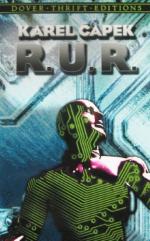|
This section contains 311 words (approx. 1 page at 400 words per page) |

|
R.U.R. Summary & Study Guide Description
R.U.R. Summary & Study Guide includes comprehensive information and analysis to help you understand the book. This study guide contains the following sections:
This detailed literature summary also contains Bibliography and a Free Quiz on R.U.R. by Karel Čapek.
When Karel Capek's R.U.R. (the acronymic title is short for "Rossum's Universal Robots") was first performed in 1921, it became a major international success and made Capek an internationally known playwright. Although R.U.R. may appear slightly dated nearly eighty years later, the concerns expressed by the playwright are still interesting to modern audiences, and the play is still performed in regional theatres. Capek's drama is also responsible for coining a new word, "robot," which became an important fixture of Hollywood films, especially the B-films of the 1950s. The word "robot" is derived from the Czech word robota, meaning forced labor, but it was the topic of the play, that technology can imperil the world, that made the play controversial.
The problems this play deals with are not the realities of everyday life; instead Capek is exploring the larger issues of the human condition. With technology booming immediately after the end of World War I, R.U.R. touched on the concerns of many people. The idea of a utopian society to replace the one fractured by the horror of the first World War was especially appealing to audiences, some of whom were deeply disturbed by Capek's vision of how technology might be misused. Capek's concerns about the dehumanization of man through technology provides the central core of this play, and it is this motif that warns of the destructive force of technology.
Although contemporary assessments of Capek's play frequently cite the stereotypical nature of the characters, there is enough depth to them to involve an audience, and this involvement is one of the play's strengths. At performances of R.U.R., audiences and critics were both fascinated with the idea of non-humans that appeared human and terrified at the implications for human destruction at the hand of technology. These two reactions led to the play's success.
Read more from the Study Guide
|
This section contains 311 words (approx. 1 page at 400 words per page) |

|



